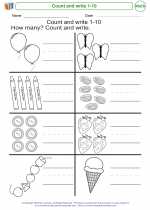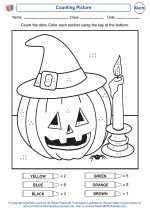Count and Write 1-10
Counting and writing numbers from 1 to 10 is an essential early math skill for kindergarten students. Here's a simple guide to help your child master this concept:
- Start by introducing the numbers 1 to 10 to your child. Show them how each number looks and sounds.
- Encourage your child to practice writing each number. Provide them with worksheets or allow them to use a chalkboard or whiteboard to write the numbers.
- Use visual aids such as counting blocks or flashcards to help your child associate the written number with its quantity.
- Engage in counting activities with your child, such as counting toys, fruits, or other everyday objects. This will reinforce their understanding of the relationship between the written number and the quantity it represents.
- Offer positive reinforcement and praise as your child progresses in counting and writing numbers 1 to 10.
With consistent practice and encouragement, your child will gain confidence in counting and writing numbers 1 to 10, setting a solid foundation for further math skills.
[Count And Write 1-10] Related Worksheets and Study Guides:
.◂Math Worksheets and Study Guides Kindergarten. Count and write 1-10
Coloring Worksheet Count and write 1-10
Count and write 1-10  Coloring Worksheet
Coloring Worksheet Count and write 1-10
Count and write 1-10  Worksheet/Answer key
Worksheet/Answer key Halloween - Counting Picture
Halloween - Counting Picture 

 Coloring Worksheet
Coloring Worksheet
 Worksheet/Answer key
Worksheet/Answer key

The resources above cover the following skills:
Counting and Cardinality
Know number names and the count sequence.
Count to 100 by ones and by tens. [K-CC1]
Count forward beginning from a given number within the known sequence (instead of having to begin at 1). [K-CC2]
Count to tell the number of objects.
Understand the relationship between numbers and quantities; connect counting to cardinality. [K-CC4]
When counting objects, say the number names in the standard order, pairing each object with one and only one number name and each number name with one and only one object. [K-CC4a]
Understand that the last number name said tells the number of objects counted. The number of objects is the same regardless of their arrangement or the order in which they were counted. [K-CC4b]
Understand that each successive number name refers to a quantity that is one larger. [K-CC4c]
Count to answer “how many?” questions about as many as 20 things arranged in a line, a rectangular array, or a circle, or as many as 10 things in a scattered configuration; given a number from 1-20, count out that many objects. [K-CC5]
Compare numbers.
Compare two numbers between 1 and 10 presented as written numerals. [K-CC7]